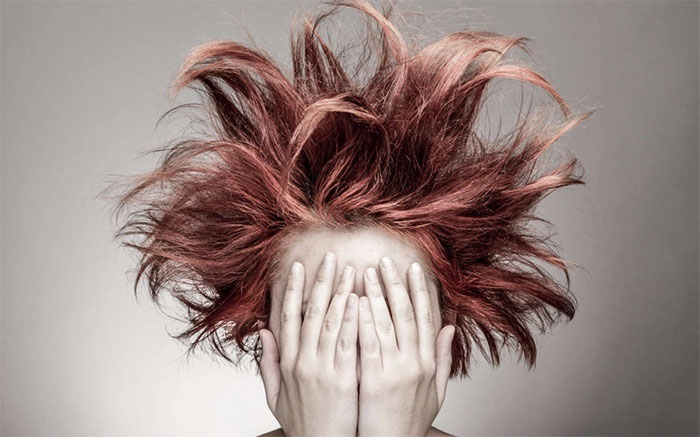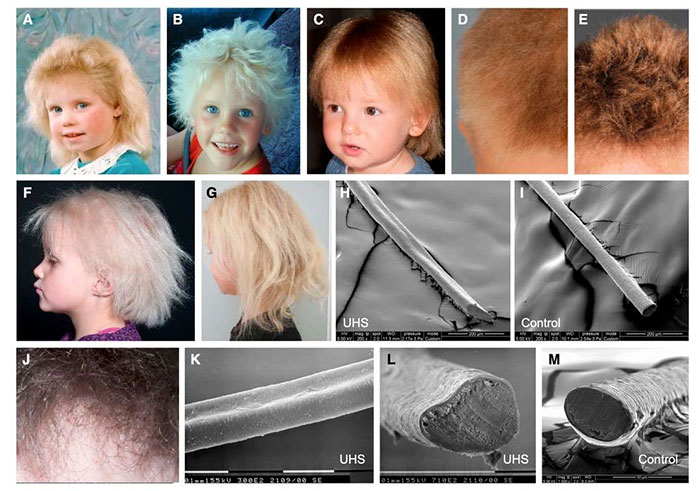Strange hair syndrome that can't be combined, disappears on its own as an adult
This syndrome causes the hair to stand up, dry, thick and impossible to comb, which surprisingly disappears on its own as a person matures.
In 1978, a 2-year-old Ashkenazi Jewish boy became the focus of pediatricians at a hospital in Tel Aviv (Israel). Owning a very special hair has made the doctors curious, because other than that the child is completely normal.

There is currently no specific treatment for incombinable hair syndrome, patients need to be patient until adulthood, the hair will return to normal.
Specifically, his hair is light blonde with an odd shine, dry thick, foamy, and simply not combable. Doctors analyzed Ashkenazi's hair with an electron microscope to visualize its structure.
The results showed that the hair was cut across by one or two longitudinal grooves that changed their shape. Instead of circles or ovals, they are triangular or bean-shaped.
At the same time, on the other side of the Mediterranean, French doctor André Dupré and colleagues made similar observations. A family in which three children all possess "indomitable steadfastness" hair.
The mother and father say they used to be the same before it disappeared for many years. Doctors first decided to name this strange condition: uncombinable hair syndrome.

Children with uncombinable hair syndrome will return to normal when they are adults.
At the time the disease was first named, its origin was still unknown, but the fact that entire families are affected still gives doctors clues, after studying experts for that uncombinable hair syndrome is genetic.
In 2016, German researchers performed a genetic study on 11 patients with "rebellious" hair. The first family to participate in the study was British, with two children with normal hair and two others with non-coherent hair syndrome.
Analysis of the patient's genome, specifically the PAD13 gene located on chromosome 1, highlighted a nonsense mutation in the latter that resulted in it appearing on both versions of the gene.
Genetic analysis of other patients confirmed that mutations in PAD13 are indeed the cause of uncombined hair syndrome, as well as mutations in TGM3 and TCHH.
These three genes encode homologous proteins: PAD13 and TGM3 are enzymes and TCHH is a structural protein, the target of the first two genes. All three are involved in hair formation.
Because the disease goes away on its own in adulthood, but most people with this syndrome are between the ages of 3 months and 12 years, they don't cause other health problems, so there's no treatment.
Diagnosis is based on confirmation of abnormal shape of some hairs, detected, seen under electron microscope. Besides, experts also carry out many other tests, to find out whether the influence of this hair leads to other diseases or not.
The best medicine to cure this strange disease is patience, because there is no specific medicine, so the patient has to wait until adulthood, the phenomenon of dry, incombinable hair will disappear and become back to normal.
- Strangely, she has a straight hair that can't be brushed
- Video: Syndrome causes many addicts to pluck their hair and hair
- Girls with rare diseases: 'Princess in Grimm's fairy tale'
- Strange fear syndrome that you may be suffering from but don't know how to call
- Hair color change syndrome named the most beautiful woman in Europe
- Fertilizer from ... hair
- Little girls brush their heads and die
- Strange diseases discovered in the 21st century
- Strange diseases
- Strange syndrome, a woman can talk about ... 4 foreign voices
- Strange girl with syndrome
- Strange girl with syndrome
 13 causes of non-itchy rash
13 causes of non-itchy rash How the mouse with human ears changed the world?
How the mouse with human ears changed the world? The truth about 'fried rice syndrome!
The truth about 'fried rice syndrome! What is dental implant?
What is dental implant?